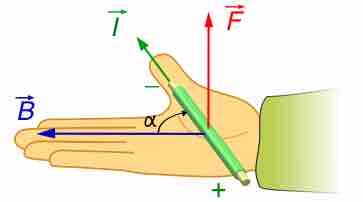Electric Current and Magnetic Fields
Electric current produces a magnetic field. This magnetic field can be visualized as a pattern of circular field lines surrounding a wire. One way to explore the direction of a magnetic field is with a compass, as shown by a long straight current-carrying wire in . Hall probes can determine the magnitude of the field. Another version of the right hand rule emerges from this exploration and is valid for any current segment—point the thumb in the direction of the current, and the fingers curl in the direction of the magnetic field loops created by it.

Magnetic Field Generated by Current
(a) Compasses placed near a long straight current-carrying wire indicate that field lines form circular loops centered on the wire. (b) Right hand rule 2 states that, if the right hand thumb points in the direction of the current, the fingers curl in the direction of the field. This rule is consistent with the field mapped for the long straight wire and is valid for any current segment.
Magnitude of Magnetic Field from Current
The equation for the magnetic field strength (magnitude) produced by a long straight current-carrying wire is:
For a long straight wire where I is the current, r is the shortest distance to the wire, and the constant 0=4π10−7 T⋅m/A is the permeability of free space. (μ0 is one of the basic constants in nature, related to the speed of light. ) Since the wire is very long, the magnitude of the field depends only on distance from the wire r, not on position along the wire. This is one of the simplest cases to calculate the magnetic field strenght from a current.
The magnetic field of a long straight wire has more implications than one might first suspect. Each segment of current produces a magnetic field like that of a long straight wire, and the total field of any shape current is the vector sum of the fields due to each segment. The formal statement of the direction and magnitude of the field due to each segment is called the Biot-Savart law. Integral calculus is needed to sum the field for an arbitrary shape current. The Biot-Savart law is written in its complete form as:
where the integral sums over the wire length where vector dℓ is the direction of the current; r is the distance between the location of dℓ, and the location at which the magnetic field is being calculated; and r̂ is a unit vector in the direction of r. The reader may apply the simplifications in calculating the magnetic field from an infinite straight wire as above and see that the Biot-Savart law reduces to the first, simpler equation.
Ampere's Law
A more fundamental law than the Biot-Savart law is Ampere's Law, which relates magnetic field and current in a general way. In SI units, the integral form of the original Ampere's circuital law is a line integral of the magnetic field around some closed curve C (arbitrary but must be closed). The curve C in turn bounds both a surface S through which the electric current passes through (again arbitrary but not closed—since no three-dimensional volume is enclosed by S), and encloses the current. You can think of the "surface" as the cross-sectional area of a wire carrying current.
The mathematical statement of the law states that the total magnetic field around some path is directly proportional to the current which passes through that enclosed path. It can be written in a number of forms, one of which is given below.
where the magnetic field is integrated over a curve (circumfrence of a wire), equivalent to integrating the current density (in amperes per square meter, Am-2) over the cross section area of the wire (which is equal to the permeability constant times the enclosed current Ienc). Ampere's law is always valid for steady currents and can be used to calculate the B-field for certain highly symmetric situations such as an infinite wire or an infinite solenoid. Ampere's Law is also a component of Maxwell's Equations.
Force on a Current-Carrying Wire
The force on a current carrying wire (as in ) is similar to that of a moving charge as expected since a charge carrying wire is a collection of moving charges. A current-carrying wire feels a force in the presence of a magnetic field. Consider a conductor (wire) of length ℓ, cross section A, and charge q which is due to electric current i. If this conductor is placed in a magnetic field of magnitude B which makes an angle with the velocity of charges (current) in the conductor, the force exerted on a single charge q is

Force on a Current-Carrying Wire
The right hand rule can be used to determine the direction of the force on a current-carrying wire placed in an external magnetic field.
So, for N charges where
the force exerted on the conductor is
where i = nqvA. The right hand rule can give you the direction of the force on the wire, as seen in the above figure. Note that the B-field in this case is the external field.